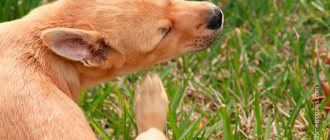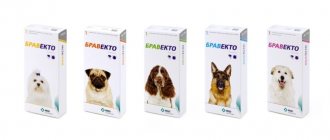Cases when a dog has spots on its tongue are not uncommon and should not frighten the owner. In 99% of cases, this phenomenon does not pose a danger and turns out to be natural. The general condition of the animal makes it possible to determine quite well whether the pigmentation that has appeared is harmful to the pet’s health. Most often, the spots on the tongues of four-legged friends are dark brown or even black. They are considered normal and can be present in a puppy from birth or occur in adult animals at any age.
When determining whether a dog matches the breed, such a phenomenon is not assessed as a deviation from the standards, which is important for breeders who participate in exhibitions and allow the animal to be bred. Most often, black spots on the tongue appear in representatives of the following breeds:
- German Shepherd.
- Giant Schnauzer.
- Dog.
- Newfoundland.
The spots can be single or multiple.
Signs of bad stains
The fact that spots on a dog’s tongue may turn out to be malignant neoplasms can be understood by a number of signs, although it will not be possible to make a 100% diagnosis without blood biochemistry and tissue biopsy. The following manifestations indicate that the stain is dangerous:
- reddish color of the spot;
- the stain has the color of rotten meat;
- when touching a place with a changed color, the dog shows that it is in pain;
- disturbances noticeable to the eye when eating and drinking;
- general malaise in the pet;
- growth of the spot;
- formation of a wound at the site of the stain.
If cancer occurs, urgent surgical treatment is required. After it, depending on the cause of tumor growth, an additional course of hormonal or chemotherapy may be given.
Causes of spots on the tongue
There are different etiologies. Since the place is hidden, the owner does not immediately notice the color and thinks that it indicates some problems in the pet’s health. However, this is not always the case, as veterinary experience shows. They can be either pathogenic (painful) or harmless.
Red spots on the tongue: factors of appearance
It is worth distinguishing spots from rashes. The first is the pigmented area. Young puppies often get injured by playing too hard with hard toys. Adult dogs who are interested in wasps or bees are no less curious. In these cases there will be slight swelling and itching, obvious anxiety.
Burns are caused by curiosity or by eating too hot food. Wounds on mucous membranes heal quickly, only in the case of an insect bite, care is taken to avoid anaphylactic shock.
An extremely rare red spot on the mucous membrane is a sign of canine distemper - the tongue is not a typical place for the symptom to appear.
White spots and dots, coating on the dog's tongue
This color is an indicator of pathogenic flora on the mucous membranes. Sign of diseases:
Due to the long list, the real cause is determined after research. Pay attention to stool disorders, unpleasant odor, fever, bloating, tremors, etc.
Dark spots on the tongue: normal or not?
They are the norm if nothing bothers the puppy or dog. They are considered analogous to birthmarks in humans. Shepherds, Great Danes, Newfoundlands and even Labradors are predisposed to dark hidden marks. They are even, smooth, not inflamed.
Why does a brown spot appear on the tongue?
Just like humans, dogs develop distinctive characteristics as they grow older. A light or black spot on the tongue is new pigmentation, a mole, which was mentioned above.
When should you not worry?
Spots on a dog's tongue, which do not pose a danger, appear at any age in the same way as moles in humans. They do not cause discomfort, and the process of their formation goes unnoticed. The main place of their localization is the middle and root of the tongue, although their appearance at the end of the organ cannot be completely excluded.
In most cases, special pigmentation of a pet’s tongue is discovered by accident when examining its oral cavity for another reason. The size and shape of the spots vary greatly.
In puppies, such marks on the tongue are similar to birthmarks in humans, which last a lifetime. They may become brighter or paler with age. Their size does not increase.
With a predisposition to the appearance of pigmentation, the number of spots on the tongue in dogs, like moles on the human body, may increase over the years. Therefore, sometimes the tongue, due to the fact that individual spots merge together, turns out to be almost completely black.
Spots on the tongue - as a feature of the breed?
There are some dog breeds that are characterized by tongue pigmentation. Spots can appear immediately from birth and later, at the age of several months to 3 years.
These breeds include:
- Newfoundland.
- Dog.
- Giant Schnauzer.
- Labrador.
- German Shepherd.
Pigment spots on the tongue of these animals are not a pathology. Such dogs are allowed for exhibitions and participate in crossing for purebred offspring.
Spots can be small, multiple or single (large, medium, small). Their shade is dark - black or dark gray. The structure of the tongue in the area of the spot is not disturbed. With age, the nature of age spots does not change.
Other reasons
Dark spots on a dog’s tongue, and sometimes light ones, can occur for a number of less common reasons. For the most part, they are not dangerous.
- Papillomas. They appear due to a virus and extremely rarely develop into cancer. They initially appear as small white spots, which can become dark after a significant period of time. Papillomas almost do not rise above the surrounding tissues and do not interfere with the animal. Such formations rarely reach large sizes. The development of such spots, which can be not only on the tongue, but also on the palate and lips, begins at the moment of a decline in immunity, when the virus is not restrained by the body’s natural defenses. After the normal state of the immune system is restored, papilloma spots often disappear on their own. If they are very large and bother the dog, they may be surgically removed.
- Traces after injuries. If a dog's tongue has been burned or seriously injured, a dark spot often appears in the area where the damage was, which is a scar with intense pigmentation. Its color is usually brown, but can also be black. Such spots, if you feel them, are denser than the tongue. The dog does not experience any unpleasant sensations when they are touched. Gradually, over time, such scars become lighter and sometimes disappear completely. There is no need to treat them as they are a natural tissue healing process.
- Malocclusion. A similar phenomenon occurs more often in dogs with a shortened upper jaw, when, due to the peculiarity of its structure, the animal’s teeth constantly touch the tongue. This leads to local irritation, and due to friction, a change in pigmentation begins - not bright brownish spots appear. They do not differ to the touch from surrounding tissues and do not change with age. Spots form soon after teeth are replaced and remain until the dog’s teeth fall out with age, which happens in old age.
Black spots on a dog’s tongue are not a pathology and do not threaten the pet’s life, so owners should calmly react to their appearance.
Dangerous spots on a dog's tongue
Not all changes in a dog's tongue are harmless. Some spots are symptoms of serious diseases. We will find out when anxiety is justified and the animal needs treatment.
White spots
They look like plaque. They can cover the entire tongue, located at the root or along the edges. They can be persistent or transient (for example, they form after sleep and are less pronounced after eating). Sometimes mixed with
yellowish tint.
The symptom is characteristic of diseases of the gastrointestinal system, such as:
- gastritis;
- dysbacteriosis;
- stomach ulcer;
- duodenitis.
In rare cases, white spots on the tongue are a consequence of thrush (mycosis) or blood diseases - leukemia, anemia. Only a specialist can make an accurate diagnosis.
Brown spots
These could be moles or pigmentation. Especially if they are close to the shade of the animal's fur. If brown spots on a dog’s tongue resemble the shade of rotten meat, bleed or increase in size, oncology is possible. In such cases, other symptoms will be noticeable - loss of appetite in the pet, obvious signs of pain when touching the tongue, lethargy, and weakness.
Courses of treatment or surgery can save the animal. The main thing is not to put off visiting a specialist.
Blistered spots
Small bubbles and blisters are a sign of stomatitis. The cause of infection is the dog's poor oral hygiene or poor quality food.
Stomatitis is treated by treating the mouth with an antiseptic. During this period, a diet is observed. The burn also appears as blisters. But an adult dog itself will not take hot food into its mouth.
Burning of the tongue is possible when puppies play with children (they put a hot sausage, cutlet, etc. in the mouth) or when absorbing poisonous plants or chemicals. Not all dogs are smart; some swallow things that are not worth it.
Burns are treated with special regenerating ointments, rubbing the tongue with an infusion of healing herbs (chamomile, calendula, sage, string).
Red spots
The most dangerous sign. Red spots on a dog's tongue are almost always an infection or inflammation. There are many diseases that cause red rashes, formations, and spots on the tongue.
The most common:
- Papillomatosis. Has a viral etiology. The tongue becomes covered with small, pink-red thread-like papillomas. If the virus is not treated, it risks becoming malignant. Your dog develops growths on his gums that can interfere with eating.
- Helminthiasis. Some types of parasites cause a reaction on the mucous membranes. The tongue becomes stained and swollen, the animal eats worse and looks sick.
- Bacterial infections. Refers to ulcerative stomatitis.
- Tuberculosis.
- Plague of carnivores.
- Dermatomycosis.
The cause of red spots on the tongue and mucous membranes is an allergy. Periodontitis (inflammation of the periodontal tissues) over a long period of time causes inflammation in the entire oral cavity.
What to do if red spots are found on the dog’s tongue and mouth?
In such situations, you cannot self-medicate without identifying the exact nature of the pathology. Some infections that affect the mucous membranes of animals are also dangerous for humans. The only reasonable solution would be an urgent visit to the veterinary clinic. Inspection and testing are required. The listed diseases can be successfully treated.
As a preventative measure, inspect your dog's mouth once a week. Feed your pet only food approved for the breed. The diet should be balanced. Strong immunity is the key to health. Get regular preventive examinations from your veterinarian and get your vaccinations up to date.
What and how you can help at home
It is impossible to cure stomatitis in a dog on your own without visiting a veterinarian (at least without consequences). No owner will be able to determine exactly what caused this disease. The main point in treatment is to eliminate the cause of inflammation, i.e. Without its precise definition, any treatment procedures will be in vain. It is always better to visit a veterinary clinic and then follow the veterinarian's instructions.
Self-treatment is permissible only for catarrhal stomatitis, when there are no ulcerations or when the ulcers are small and not extensive. In the future, you should take the dog to an appointment with a veterinarian, because... It is imperative to determine the cause of stomatitis. This is especially true if no signs of relief appear within 2-3 days and there are suspicions that the stomatitis is secondary.
We recommend reading: The cat pees often and the urine is brown
There is no need to do anything if pus, papillomas are found in the mouth, the body temperature rises or the dog is lethargic!
What can you do before visiting the veterinarian?
- Examine the oral cavity and, if possible, remove any detected foreign objects that injure the mucous membrane (bone fragments, blades of grass, wood chips, splinters, etc.). If this cannot be done, see a veterinarian.
- Wash your mouth twice a day using a rubber bulb, a syringe without a needle, or (the most ideal option) from a spray bottle (you can use empty and washed pharmaceutical containers from old medicines): furatsilin solution 1:5000 (per 500 ml of hot boiled water 0.1 g of furatsilin powder is taken, cooled to a warm temperature);
- barely pink manganese 1:10000 (a few grains are thrown into 0.5 liters of boiled cool water, stirred until completely dissolved, water is added until the required shade of the solution is obtained);
- strong decoctions of chamomile, St. John's wort, sage and/or oak bark (1 tsp of any herb or mixture of herbs, pour 200-250 ml of boiling water, leave for 20-30 minutes, add water to 500 ml),
- 3% hydrogen peroxide (pure, pharmacy packaging);
- freshly squeezed carrot juice.
There is no need to try to get into the wounds - this can cause pain, the liquid will independently distribute over the entire surface of the mucous membrane. With the same solutions, you can separately lubricate wounds and ulcers with moistened cotton swabs, but the risk of pain is high.
- Transfer your pet to food with a soft and liquid consistency (mucus liquids, jellies, liquid porridges, soups with meat broths, milk, acidophilus, minced fish/meat). Monitor the temperature of the food - it should not be hot or cold. If the lesions of the mucous membrane are very extensive and deep, you can keep your pet on a starvation diet for 1-1.5 days, but with free access to drink.
- You can treat the oral cavity with the following paste: honey - 1 part, aloe juice - 2 tsp, melted lard or butter - 1 part, streptocide - 2-4 g, cocoa butter - 1 tsp. All components are melted in a water bath at a temperature of 40°C. Mix thoroughly. The entire mouth is treated twice a day.
- For ulcerative stomatitis, after each meal, you need to wipe the dog’s teeth with a swab soaked in lemon juice. This prevents the formation of plaque, which with stomatitis forms quickly and abundantly due to developing bacteria.
Under no circumstances should you lubricate your dog’s lips or mucous membranes with iodine tincture, which is found in every human first aid kit. The likelihood of allergic reactions is high, and the additional irritating effect of iodine can lead to tissue death, reducing the rate of healing of ulcers and wounds.
How to treat stomatitis in a puppy?
In newborns, stomatitis most often develops against the background of improperly growing teeth and malocclusion. Usually everything is limited to catarrhal stomatitis, which can be treated in the same ways as in adult dogs. It goes by quite quickly. An exception is papillomatous stomatitis - self-healing usually occurs after 2-3 months, otherwise antitumor and antiviral treatment is carried out only by a veterinarian.
Spitz and miniature poodles are two breeds in which stomatitis develops very quickly and is extremely severe, with the formation of deep ulcers and tissue necrosis even on the roof of the mouth. Any self-medication in these breeds is prohibited! At the first suspicion of stomatitis, you should immediately contact a specialist.










